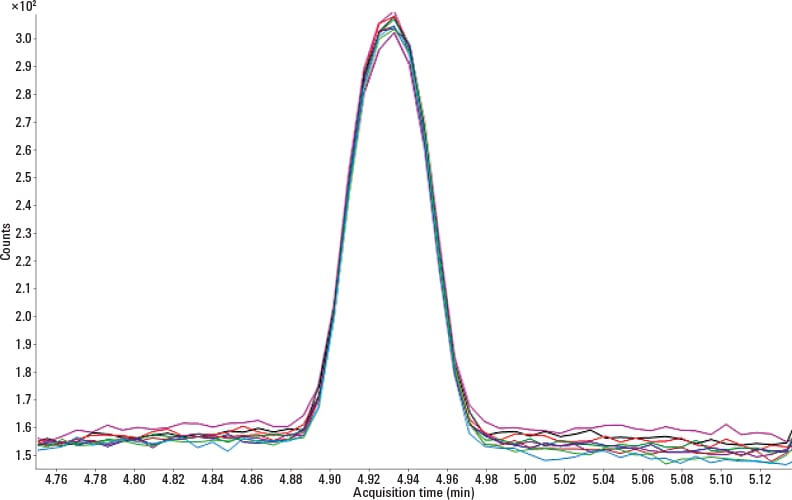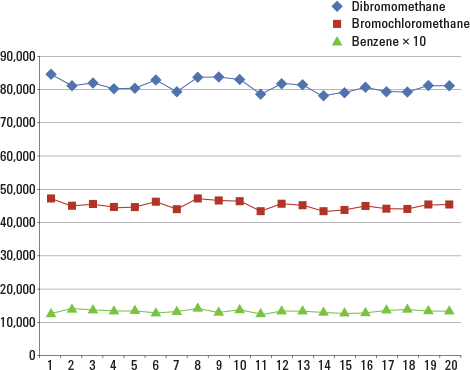Access Agilent eNewsletter April 2016

Agilent 5977B GC/MSD with HES offers improved VOC detection limits
Peter Gautschi and Harry Prest, Agilent Senior Applications and R&D Scientists
Water is the fundamental matrix of this world. Assessing its purity and identifying its contents has been an ever-evolving mission of chemists. Trace organic contaminants have always posed a great challenge. These contaminants have been classified as volatile and semi-volatile, based on differing analytical requirements. Typical volatile organic compounds include vinyl chloride, chloroform, tetrachloroethane, dichloromethane, benzene, toluene, and the xylenes, with many confirmed or suspected carcinogens among them.
Two techniques have emerged for assessing volatile organic compounds (VOCs) in water: headspace and purge and trap (P&T). The names are descriptive, in that headspace analysis involves analyzing the vapor above the sample, while P&T utilizes a trap that is then desorbed for analysis. Because P&T actively purges samples, it has yielded lower detection limits. Due to issues with other water matrices, the process of purging limits the sample type to drinking waters. Headspace is therefore the more attractive option, as it enables the study of more types of water samples, with less risk.
The US (EPA) currently stipulates P&T analysis, while Europe and other regions have adopted the headspace method. With the introduction of the new Agilent Headspace Sampler and the revolutionary 5977B GC/MSD with high-efficiency source (HES), detection limits for headspace analysis are now low enough to change the game.
Reproducibly low MDLs for volatile organics
Recently, the Agilent 5977B GC/MSD system with high-efficiency source (HES), the Agilent 7697A Headspace Sampler, and an Agilent 7890B GC were used to perform MDL analysis at 0.04 µg/L (N=9). The results are shown in Table 1. All MDLs are below 0.025 µg/L or 25 ppt with the exception of 2 compounds, which have MDLs below 30 ppt. The majority of compounds have MDLs below 0.015 µg/L, including some compounds with relatively low response. Expanded results are shown in Agilent publication 5991-6539EN.

Figure 1. Linearity to 20 µg/L (external standard) for trans-1,2-dichloroethene, 1,2-dibromoethane, and bromoform.

Figure 2. Overlay of the EIC for 9 replicate injections of vinyl chloride at 0.04 µg/L.

Figure 3. Peak areas for replicate injections (n=20) showing system stability as a function of time. Benzene 〜0.01 ppb, dibromomethane 1.5 ppb, bromochloromethane 0.8 ppb.
| Name | RT | Quant ion | MDL |
|---|---|---|---|
| Vinyl chloride | 4.934 | 62 | 0.004 |
| Bromomethane | 5.611 | 93.9 | 0.003 |
| Chloroethane | 5.806 | 64 | 0.003 |
| 1,1-Dichloroethene | 7.007 | 95.9 | 0.008 |
| trans-1,2-Dichloroethene | 8.007 | 95.9 | 0.009 |
| 1,1-Dichloroethane | 8.554 | 63 | 0.004 |
| cis-1,2-Dichloroethene | 9.19 | 95.9 | 0.011 |
| 2,2-Dichloropropane | 9.208 | 77 | 0.013 |
| Bromochloromethane | 9.47 | 127.8 | 0.004 |
| 1,1,1-Trichloroethane | 9.769 | 96.9 | 0.005 |
| 1,1-Dichloro-1-propene | 9.921 | 75 | 0.012 |
| Carbon tetrachloride | 9.94 | 116.9 | 0.003 |
| Benzene * (blank issue) | 10.165 | 78 | 0.009 |
| 1,2-Dichloroethane | 10.202 | 62 | 0.006 |
Table 1. MDLs for selected compounds calculated for 9 replicates at 0.04 mg/L.
Excellent linearity over a broad quantitation range
Figure 1 shows linearity achieved over the concentration range 0.02 to 20 µg/L for several representative compounds. Signal improvement is not complicated by interferences and the results show a significant improvement in detection limits.
Remarkably stable system response over time
The results of retention time data for vinyl chloride for 9 replicate injections (shown in Table 1) were overlaid to demonstrate the peak reproducibility.
Overall stability of the analysis was demonstrated by injecting replicates of local tap water to monitor some naturally occurring compounds (Figure 2). Plots of peak areas for replicate injections of selected compounds show the stability of the system over time (Figure 3).
Significantly improved volatile organic analysis
The results of our analyses suggest significant improvement in detection limits can be achieved in static headspace analysis of volatile organics by using the Agilent 5977B GC/MSD equipped with the new high-efficiency source (HES). The signal improvement is not complicated by interferences and results in clearly enhanced detection. Lower MDLs for VOA compounds will benefit sampling and method robustness.
Learn more about the capabilities of the Agilent 5977B GC/MSD with high-efficiency source (HES) and see how it can transform water quality analysis. Then explore Agilent’s wide range of gas chromatography products, columns, and supplies. Contact your Agilent Representative to learn how our integrated solutions can improve the efficiency of your lab’s diagnostic analysis of organic contaminants.
Stay informed about the applications that are important to you
Subscribe to Access Agilent
Our free customized
monthly eNewsletter
Article Directory – April 2016
All articles in this issue
 Analyze low-ppm levels of active sulfur compounds with inert sample path on the Agilent 490 Micro GC
Analyze low-ppm levels of active sulfur compounds with inert sample path on the Agilent 490 Micro GC Fast arsenic speciation for food and urine analysis with Agilent LC-ICP-QQQ
Fast arsenic speciation for food and urine analysis with Agilent LC-ICP-QQQ Simplify achiral-chiral analysis of warfarin metabolites using Agilent 2D-LC/MS solutions
Simplify achiral-chiral analysis of warfarin metabolites using Agilent 2D-LC/MS solutions Optimized detection of gaseous sulfur compounds using Agilent J&W DB-Sulfur SCD GC column and Inert Flow Path
Optimized detection of gaseous sulfur compounds using Agilent J&W DB-Sulfur SCD GC column and Inert Flow Path Oil-free laboratory vacuum eliminates oil mess and disposal costs
Oil-free laboratory vacuum eliminates oil mess and disposal costs Eliminate conventional SEC roadblocks with Agilent AdvanceBio SEC columns
Eliminate conventional SEC roadblocks with Agilent AdvanceBio SEC columns Fast, economical assessment of herbals with Agilent 1290 Infinity LC system and LC columns
Fast, economical assessment of herbals with Agilent 1290 Infinity LC system and LC columns Agilent 5977B GC/MSD with HES offers improved VOC detection limits
Agilent 5977B GC/MSD with HES offers improved VOC detection limits
Figure 1

Linearity to 20 µg/L (external standard) for trans-1,2-dichloroethene, 1,2-dibromoethane, and bromoform.
Figure 2

Overlay of the EIC for 9 replicate injections of vinyl chloride at 0.04 µg/L.
Figure 3

Peak areas for replicate injections (n=20) showing system stability as a function of time. Benzene 〜0.01 ppb, dibromomethane 1.5 ppb, bromochloromethane 0.8 ppb.